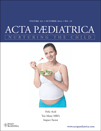Changing trend of persistent diarrhoea in young children over two decades: observations from a large diarrhoeal disease hospital in Bangladesh
Abstract
Aim: We studied the changing trend and factors associated with persistent diarrhoea (PD) in under-five children presenting to a large diarrhoeal disease hospital in urban Dhaka, Bangladesh, over the last two decades.
Methods: We used an unmatched case–control design, with a case (persistent diarrhoea; n = 944) to control (acute diarrhoea; n = 2832) ratio of 1:3 attending the Dhaka Hospital of icddr,b between 1991 and 2010.
Results: The proportion of children with PD decreased significantly from 8% in 1991 to 1% in 2010. The proportion of breastfeeding practices, measles vaccination coverage and vitamin A supplementation among 12–59 months old improved from 79% to 85%, 69% to 85% and 26% to 74%, respectively, which were significant. Although the isolation of rotavirus from stool in children with PD and acute diarrhoea increased, the isolation of Shigella spp., and Vibrio cholerae O1 decreased significantly. In a logistic regression analysis, wasting (OR = 1.62), use of antibiotic before attending hospital (OR = 5.94), absent clinical dehydration (OR = 1.53) and bloody/mucoid stool (OR = 3.33) were significantly associated with persistent diarrhoea.
Conclusion: There, thus, is a need to integrate an appropriate and sustainable deterrent strategy to take the benefit of the significant reduction in prevalence as well as risks of PD in such population.




